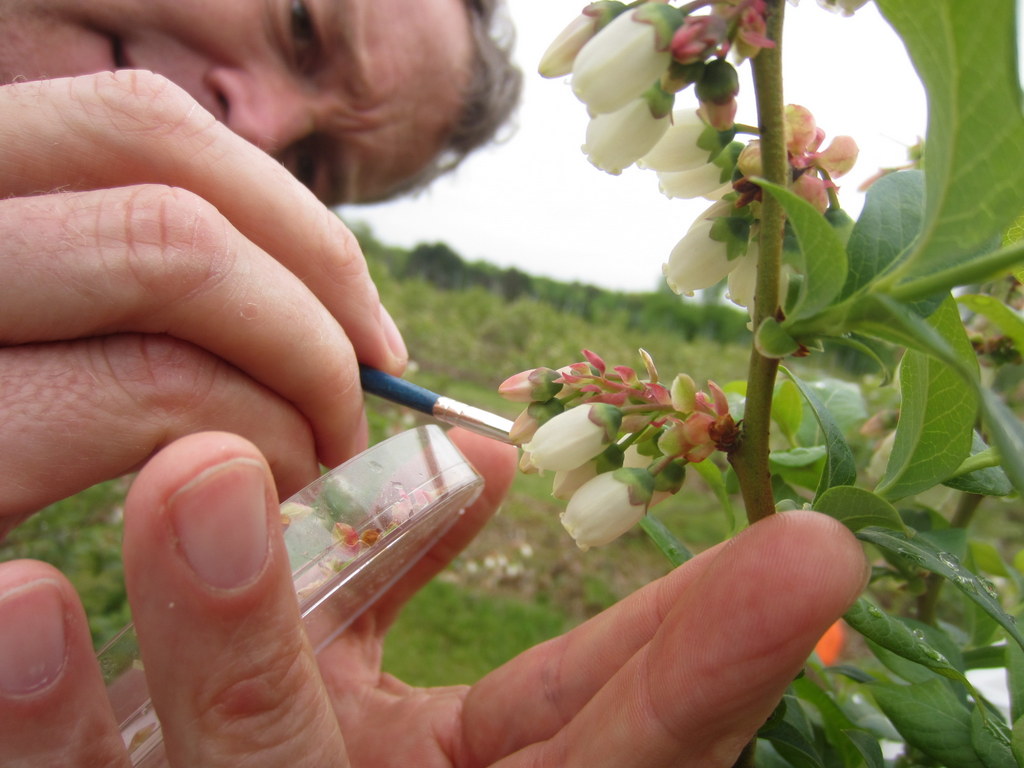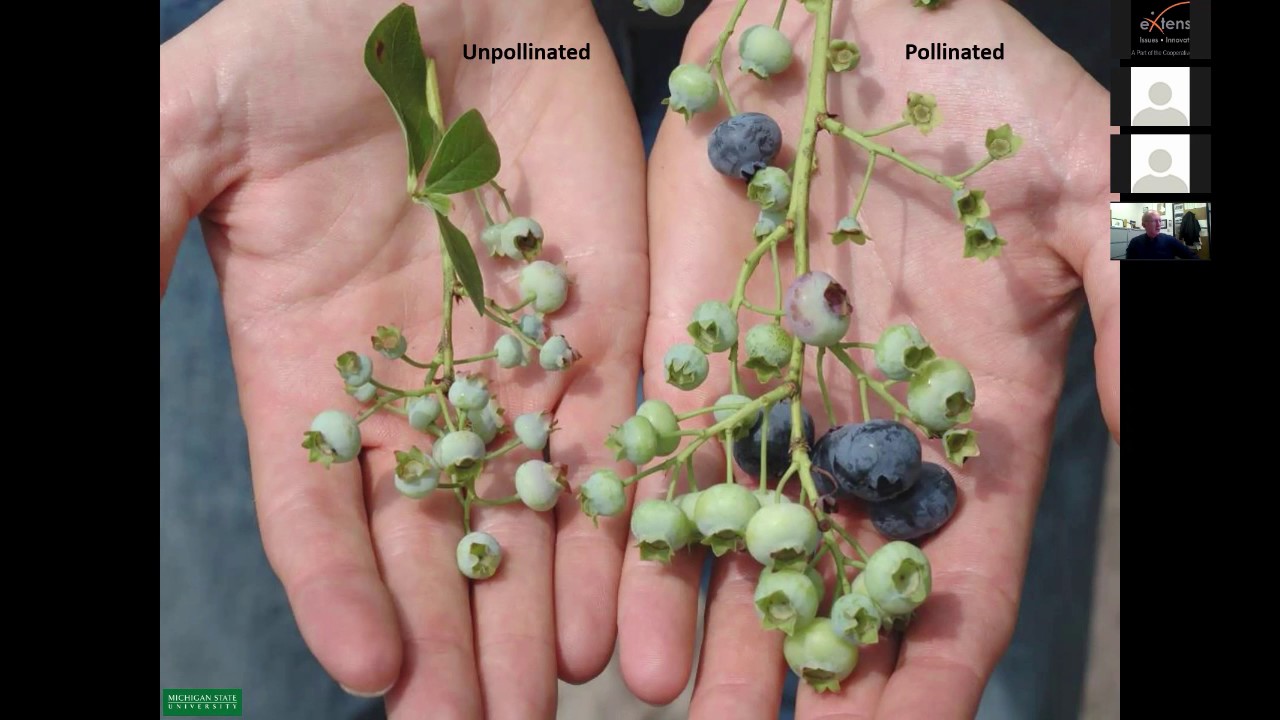To pollinate blueberry bushes, you can gently shake or brush the flowers to release the pollen. Additionally, you can attract pollinators like bees and butterflies to your garden to assist with pollination.
Once the flowers have been pollinated, they will develop into berries. Introducing blueberry bushes to your garden can be a delightful and rewarding experience. However, it is crucial to ensure proper pollination to promote the growth of juicy and delicious berries.
Fortunately, there are simple techniques you can employ to pollinate blueberry bushes effectively. We will explore these methods and guide you in attracting natural pollinators to optimize your blueberry yield. With a little effort, you can enjoy a bountiful harvest of these succulent fruits right in your backyard. So, let’s dive in and discover how to pollinate blueberry bushes.

Credit: learn.uvm.edu
The Importance of Pollination for Blueberry Bushes
Blueberry pollination plays a crucial role in the process of fruit production. Without proper pollination, blueberry bushes would not be able to bear the delicious fruits that we all love. Pollinators such as bees, butterflies, and other insects are essential in carrying out this important task.
Pollinators transfer pollen from the male parts of the flower to the female parts, allowing fertilization to occur. This is an essential step in the reproductive process of blueberry bushes. The pollen carries the necessary genetic material that enables the development of the fruit.
The role of pollinators cannot be underestimated. They visit the flowers in search of nectar and inadvertently transfer pollen, ensuring the continuation of the blueberry bush’s life cycle. By encouraging a diverse and healthy population of pollinators in your garden or blueberry farm, you can significantly enhance pollination and improve fruit yield.
Factors Affecting Blueberry Pollination Success
|
The Role Of Bees In Blueberry Pollination
The role of bees in blueberry pollination is crucial for a successful harvest. Bees are natural pollinators that transfer pollen from male to female blueberry flowers, enabling the fertilization process. This process leads to the production of healthy and abundant berries.
Understanding the importance of bees as pollinators is essential. Bees are attracted to the blueberry bushes by their vibrant flowers and sweet nectar. To attract bees to your blueberry bushes, create a bee-friendly environment by planting flowers that produce nectar and pollen. Native wildflowers, lavender, and sunflowers are excellent choices for attracting bees.
Another way to attract bees is by providing a water source such as a shallow birdbath or a hummingbird feeder filled with water. Bees need water to stay hydrated during their busy pollination activities. Placing the water source near your blueberry bushes will help attract and keep bees in the area.
How to Pollinate Blueberry Bushes : Step by Step Guide
Encouraging Native Pollinators For Blueberry Bushes
Creating a pollinator-friendly environment is essential for encouraging native pollinators to visit your blueberry bushes. Native pollinators play a crucial role in pollinating blueberry flowers, leading to a healthy fruit set and a bountiful harvest. To attract these beneficial insects to your garden, consider implementing the following practices:
- Planting native flowering plants nearby: Native plants provide a source of nectar and pollen for pollinators, attracting them to your garden. Include a variety of plants with different bloom times to provide food throughout the growing season.
- Providing nesting sites: Many native pollinators require suitable nesting habitats. Create areas with undisturbed soil, dead wood, or structures like bee hotels for bees and other small insects to nest in.
- Avoiding pesticide use: Chemical pesticides can be harmful to pollinators. Instead, opt for organic and natural pest control methods to protect your blueberry bushes without negatively impacting the pollinator population.
- Maintaining water sources: Provide shallow water sources like saucers filled with water or birdbaths with flat rocks within your garden to offer a drinking spot for pollinators.
- Reducing habitat fragmentation: Create connected habitats by incorporating hedgerows, meadows, or wildflower strips to enhance pollinator movement and create valuable corridors for them to thrive.
By implementing these practices, you can create an inviting and supportive environment for native pollinators, ensuring successful pollination of your blueberry bushes and a fruitful harvest.
Hand Pollination Of Blueberry Flowers
Hand pollination is a crucial technique for successfully pollinating blueberry bushes. By following a step-by-step guide to hand pollination, you can ensure a healthy yield of blueberries. Here are the tools and techniques you need:
| Tool | Technique |
|---|---|
| Cotton Swabs | Use a cotton swab to collect pollen from the stamen of one flower and transfer it to the stigma of another flower. |
| Small Paintbrush | Gently brush the stamen of one flower to collect pollen and then brush it onto the stigma of another flower. |
| Electric Toothbrush | Hold the vibrating toothbrush near the flowers to help release the pollen and aid in pollination. |
When hand pollinating blueberry flowers, it is important to follow these steps:
- Select the flowers to be pollinated and identify the stamen and stigma.
- Use the selected tool, such as a cotton swab or small paintbrush, to collect pollen from the stamen.
- Transfer the collected pollen to the stigma of another flower.
- Repeat the process for each flower you want to pollinate.
- Ensure proper cross-pollination by using different flowers for pollen collection and transfer.
- Repeat the hand pollination process regularly throughout the flowering season to maximize fruit set.
By following these guidelines and utilizing the appropriate tools and techniques, you can effectively hand pollinate your blueberry bushes and increase the yield of delicious blueberries.
Cross-Pollination Of Blueberry Varieties
When it comes to pollinating blueberry bushes, cross-pollination of different varieties is essential. This process involves transferring pollen from one variety to another, resulting in improved fruit set, yield, and overall plant health.
The benefits of cross-pollination for blueberry bushes are numerous. Firstly, it increases the chances of successful pollination, as it ensures the availability of compatible pollen. Additionally, cross-pollination enhances genetic diversity, leading to stronger and more resilient plants. This diversity also contributes to larger and tastier berries with better coloration.
Selecting compatible blueberry varieties for cross-pollination is crucial for successful results. It is recommended to choose varieties that bloom at the same time or have overlapping bloom periods. This ensures that the flowers are receptive to pollen when it is being transferred. Examples of compatible varieties include Bluecrop and Jersey, as well as Bluejay and Bluegold.
In conclusion, cross-pollination is vital for blueberry bushes as it improves pollination success, enhances genetic diversity, and results in larger and tastier berries. Choosing the right compatible varieties will ensure fruitful cross-pollination and a bountiful harvest.
Frequently Asked Questions On How To Pollinate Blueberry Bushes
What Is The Best Pollinator For Blueberries?
The best pollinator for blueberries is the honeybee, due to its ability to efficiently transfer pollen.
Do You Need 2 Blueberry Bushes To Produce Fruit?
Yes, you need 2 blueberry bushes to produce fruit.
Do Blueberry Bushes Need To Be Pollinated?
Yes, blueberry bushes need to be pollinated to produce fruit.
Can You Pollinate Blueberries By Hand?
Yes, blueberries can be pollinated by hand to ensure successful fertilization of the flowers.
Conclusion
Pollinating blueberry bushes is an essential step in ensuring a bountiful harvest. By understanding the different methods of pollination and implementing them effectively, you can increase fruit set and improve the overall quality of your blueberries. Whether you choose to rely on bees, hand pollination, or the assistance of a pollinator-friendly landscape, creating a favorable environment for pollinators ensures the transfer of pollen and promotes successful pollination.
Remember to consider the variety of blueberry bush you have, as each may have different pollination requirements. Additionally, providing proper care and maintenance for your plants, such as regular pruning and fertilization, will further enhance their ability to produce fruits.
By following these guidelines, you can support pollination and enjoy a bountiful harvest of delicious and healthy blueberries. Happy pollinating!

